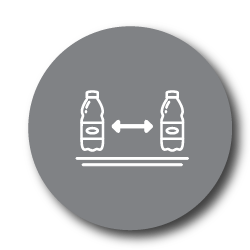Are you a retailer looking to grow your product categories and increase your bottom line? Do you want to please your customers and create repeat shoppers? If you are, then you're in luck because there are multiple ways to achieve that. And many of these coincide with category management, its process, and any corresponding actions.
If you are looking to introduce a new product category into your business, it’s better to read this article first. It lays out the best situations and circumstances for you to consider if you’re thinking of bringing a new category into your business.
About the contributors
Isabel Wessels joined DotActiv in 2017 as a senior space planner, creating data-driven planograms for one of the largest pharmacy retailers in Africa - Dis-Chem. She was promoted to account manager for Dis-Chem’s FMCG department in 2019.
Rina Wilkens joined DotActiv in 2018 as a space planner. She has since worked her way up to the position of account manager. Today, she oversees the Health Department at Dis-Chem, which includes categories such as Vitamins, Sports and Foods.
Runet Kritzinger has been with DotActiv since 2015. She currently manages the Makro Food and Liquor account and is part of DotActiv’s Cross-Functional Management Forum.
Tanya Du Plessis joined DotActiv at the beginning of 2018. She currently oversees the Makro General Merchandise account. Makro is a wholesaler chain and subsidiary of Massmart that has international ties to Walmart.

You can integrate your data with a reliable category management system
The first step to setting up the opportunity to grow your product categories begins with data integration.
Here’s why: if you plan on getting started with category management, integrating your database makes it not only easier to begin with, but also to continue. That’s because you can reduce the complexity of processing your data. Also, it allows you to extract more value from your data because you can combine it with other data sets.
In a brief conversation with Joe Keenan, executive editor of Total Retail, IBM's Jane Porter, product manager of retail integration is just as adamant about the important of data integration.
By integrating your data with a reliable category management system, you can get access to a comprehensive analysis of how to improve and where. That includes advanced analysis tools and custom reports that spot growth opportunities within your sub-categories, segments or brands. You can also identify trends and make adjustments to your planograms as you go.
As for what you need to keep in mind before integrating your data, the most critical aspect is clean and classified data. Clean data should be at the heart of all of your category management actions.
Without clean and classified data, you’ll struggle to create accurate clusters, ranges, planograms and more. What’s more, you’ll struggle to consistently grow your product categories because you’ll be guessing rather than making strategic decisions.
If you’re using DotActiv software, you can learn how to clean and classify your data through this article on our DotActiv PowerBase.

You can conduct a clustering exercise
If you want to provide your customers with the products they want, thereby improving your retail business, a clustering exercise is another category management action to take.
Why? That’s simple: clustering allows you to group or cluster your stores with similar consumer shopping patterns based on criteria. It allows you to personalise your product assortment to suit the specific needs of your customers at each of your store clusters.
This also allows you to identify which categories are deserving of more space and which should be deranged to get your best-performing products the shelf space they deserve.
When setting up an effective clustering exercise in the retail sector, there are two predominant methods used. They are store-based and category-based clustering.
For store-based clustering, you’d usually group by LSM, size, store format and performance data. It’s a method which works well if you have a few store branches with distinct characteristics.
If you run convenience stores, grocery stores or hypermarkets, you may choose to group your stores according to store format. That's because the customer base for each will be relatively consistent within each format.
However, this method doesn’t consider the different categories within a store, which are approached differently due to the different customer purchasing patterns, and their wants and needs.
Meanwhile, category-based clustering uses data across all store branches to cluster stores based on similarities in chosen variables. This means that each store may fall within a different cluster for each product category.
In using this method, you can create customer-focused assortment plans that satisfy the needs of your target market.

You can execute a strong assortment planning strategy
Just as conducting a clustering exercise is critical to helping you improve the success of your product categories, so too is having an assortment planning strategy. In truth, the two work together.
Choosing the right assortment is vital for you to operate successfully as it ensures you have the right product in the right store at the right time at the right price. More importantly, assortment planning considers the financial objectives and seasonality of the product selection in a way so that both you and your customers can benefit.
If you optimise your assortment, you can identify which products your customers want. That, in turn, allows you the opportunity to grow those product categories to meet their needs.
So what makes up a strong assortment planning strategy?
For one, you need to know the sales and movement per product - your product-specific data. Knowing this, you can keep your highest contributing products in your range and remove any low contributors. This allows you to optimise your product assortment.
Keep in mind that you can also use market data here if you have any available. The market data can help you rule out any inconsistencies and spot any gaps in your assortment.
You should also know your store size. This will allow you to know whether you have space in-store to expand on categories. Your cluster information will also help since the cluster influences your assortment as we mentioned in the previous section.
You can also track competitor pricing and invest in strong visual merchandising, two points made by Matt Ellsworth, senior manager, Marketing & Demand at Wiser.

You can build data-driven planograms to grow your product categories
While the data-driven planogram is not the be-all and end-all of category management, it is the most well-known element. That is with good reason - it's a visual representation of what customers will see on the shelf in-store.
And, by building them with data, you can plan how much space and facings each product in your range deserves. By strategically using your data, you can also push more sales for a specific product or brand if you want to grow the category.
Another great aspect of data-driven planograms is that you can import new data to update and adjust your range as shopper behaviour changes. In this way, you can also ensure that you stock products that meet the needs of your shoppers.
Planograms also help you to bring your strategy to life.
As for what you’d need, here are a few elements:
Sales data is the obvious one. This includes monetary sales and the number of units sold over a specific period. If you’re using DotActiv software, or intend to, its best practice to build any planogram using at least six months of data.
Then you need a confirmed product assortment. The number of products in your range can vary so long as it’s final when you begin building your planogram. It also needs to match your category.
You also need to know and understand the strategy. By aligning internally around the role of your category, you can better understand how your customer behaves. This also affects the positioning of products on the shelf.
Finally, you’d need SKU and Fixture information as well as your product attributes.

You can optimise your floor plans
A final category management action to take to improve the business is to optimise your floor plans.
But can this action help you grow your product categories? For that, you need to consider the purpose of floor planning. It has three objectives:
- To please your customers with a logical product flow;
- To reduce floor congestion during peak shopping hours; and
- To maximise the selling potential of your retail space.
By meeting all three objectives, you can ensure that you don’t waste any floor place. What’s more, you can ensure category growth because you’ve provided each grouping with the proper space allocation relative to their overall sales contribution.
When optimising your floor plan, consider the following steps:
- Decide on your category roles;
- Draw up your initial floor plan; and
- Decide on the appropriate amount of space for each category.
The first step is similar to that found within your previously mentioned category management actions. Thus, if you’ve already chosen a category before completing the data integration process, you should have an idea.
It’s then all about drawing your floor plan to match the space in your store. This includes accounting for all the fixed items such as your doors, fittings, till points and obstructions. This will help you to understand how much space you can work with.
From there, it’s a case of looking at your data to consider your space allocation for your category. You can do this analysis by Merchandising Group, Department and Category. Again, it’s critical to allocate the most space to your top-performing products first, taking the number of products as well as their size into account.
It’s also worth noting that you should consider your units and profit contribution as much as your total sales when allocating space.
Conclusion
It’s critical to point out that category management is neither an easy or quick fix. It takes time and hard work to implement such a solution in your business. But if you get it right - choose the right solution and business to provide it, the rewards are there for you to see.
Interested in finding out more? You can book a custom exploratory consultation here or visit our online store.


